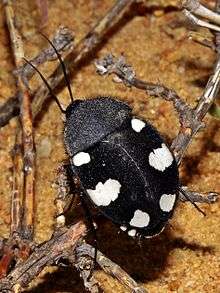Therea petiveriana
| Therea petiveriana | |
|---|---|
 | |
| From Thiruvannamalai, South India | |
 | |
| Females have shorter antennae | |
| Scientific classification | |
| Kingdom: | Animalia |
| Phylum: | Arthropoda |
| Class: | Insecta |
| Order: | Blattodea |
| Family: | Polyphagidae |
| Genus: | Therea |
| Species: | T. petiveriana |
| Binomial name | |
| Therea petiveriana (Linnaeus, 1758)[1] | |
| Synonyms [2] | |
|
Corydia petiveriana | |
Therea petiveriana, variously called the "desert cockroach", "seven-spotted cockroach" or "Indian domino cockroach", is a species of crepuscular cockroach found in southern India. They are members of a basal group within the cockroaches.[3][4] This somewhat roundish and contrastingly marked cockroach is mainly found on the ground in scrub forest habitats where they may burrow under leaf-litter or loose ground during the heat of the day.[5]
Appearance


The black and white pattern of adults is believed to have evolved to mimic the pattern of the aggressive ground beetle Anthia sexguttata that has strong defenses, including the ability to spray chemical irritants.[6] The upperside of the abdomen is orange-yellow, but is hidden by the tegmina. The spots on the asymmetrical tegmina are placed so that when closed the spots appear symmetrical. The right tegmen has a lobe that is bright orange-yellow. The species has been said to be one of the few cockroaches with "grace and beauty".[7] The head is bent back underneath the pronotal shield (hypognathous) and the ocelli (simple eyes) face forward, helping sense light and thereby time foraging activity during early morning and late evening.[5]
Reproduction
Once a female has copulated with a male, she does not allow other males to approach, kicking them away with her hind legs.[8] The eggs are laid in leaf litter.[9] Up to 13 oothecae are produced by a female over 3 to 40 days [5](blocking the ocelli of the females has been found to inhibit the laying of eggs[5]). The oothecae are produced as in other cockroaches by the secretions from the asymmetrical colleterial glands of the females.[10] Once the ootheca is extruded it is deposited in suitably moist leaf litter.[11] Nymphs lead a life hidden below the ground and may go as deep as 30 cm during the dry season.[12]
Taxonomy
This is the type species for the genus Therea. The species epithet is after James Petiver (1663–1718), who obtained specimens from Madras and its vicinity (probably from the surgeon at Fort St. George, either Samuel Browne or Edward Bulkley). Carolus Linnaeus placed the species under Cassida and described C. petiveriana and another that he called C. septemguttata, now considered a synonym.[1]
Communication
Like other cockroaches, T. petiveriana uses chemical pheromones to communicate with each other. When disturbed, they are said to raise their wings and evert lateral glands on the second and third abdominal segment. Their glandular secretions were found to contain volatile compounds N-3-methylbutylacetamide (MBA) and N-3-methylbutylpropanamide (MBP), making up nearly 60% of the volatile fraction. These chemicals appeared to induce alarm behaviour.[13]
Digestion
Like termites, these cockroaches have symbiotic flagellates and bacteria in their gut that aid in digestion.[14][15]
As pets
This species is popular as a pet in many parts of the world and are easy to keep.
References
- 1 2 Judith A. Marshall, Judith A. (1975). "The orthopteroid insects described by Linnaeus, with notes on the Linnaean collection". Zoological Journal of the Linnean Society. 78 (4): 375–396. doi:10.1111/j.1096-3642.1975.tb02266.x.
- ↑ "ZooBank".
- ↑ Grandcolas, P. (1993). "Le genre Therea Billberg, 1820: position phylogenetique, nouvelles especes, repartition, valence ecologique (Dictyoptera, Blattaria, Polyphaginae)". Canadian Journal of Zoology. 71 (9): 1816–1822. doi:10.1139/z93-259.
- ↑ Philippe Grandcolas, Yung Chul Park, Jae C. Choe, Maria-Dolors Piulachs, Xavier Bellés , Cyrille D'Haese, Jean-Pierre Farine, Rémy Brossut and Jena-Pierre Farine (2001). "What does Cryptocercus kyebangensis, n.sp. (Dictyoptera: Blattaria: Polyphagidae) from Korea reveal about Cryptocercus evolution? A study in morphology, molecular phylogeny, and chemistry of tergal glands". Proceedings of the Academy of Natural Sciences of Philadelphia. 151: 61–79. doi:10.1635/0097-3157(2001)151[0061:WDCKNS]2.0.CO;2.
- 1 2 3 4 Livingston, D & M Rajambal (1980). "Association of ocelli with the neuroendocrine system of Therea petiveriana (L.) (Blaberoidea: Polyphagidae)" (PDF). Proc. Indian Acad. Sci. (Anim. Sci.). 89 (2): 147–153. doi:10.1007/BF03179155.
- ↑ "Mimicry".
- ↑ Sharp, David (1895). The Cambridge Natural History. Volume 5. Macmillan and Co. London. pp. 233–234.
- ↑ Livingstone D & Ramani R (1978). "Studies on the reproductive biology". Proc. Indian Acad. Sci. 87: 229–247.
- ↑ Ananthasubramanian, K.S. & T.N. Ananthakrishnan (1959). "The structure of the ootheca and egg laying habits of Corydia petiveriana L". Indian Journal of Entomology. 21: 59–64.
- ↑ Annie Courrent, André Quennedey, Christine A. Nalepa, Alain Robert, Michael Lenz and Christian Bordereau (2008). "The fine structure of colleterial glands in two cockroaches and three termites, including a detailed study of Cryptocercus punctulatus (Blattaria, Cryptocercidae) and Mastotermes darwiniensis (Isoptera, Mastotermitidae)". Arthropod Structure & Development. 37 (1): 55–66. doi:10.1016/j.asd.2007.03.004. PMID 18089127.
- ↑ William J. Bell; Louis Marcus Roth; Christine A. Nalepa (2007). Cockroaches: ecology, behavior, and natural history. Johns Hopkins University Press. p. 123. ISBN 0-8018-8616-3.
- ↑ Bhoopathy, S. (1997). "Microhabitat preferences among four species of cockroaches". Journal of Nature Conservation. 9: 259–264.
- ↑ Farine, J. P., Semon, E., Everaerts, C., Abed, D., Grandcolas, P. and Brossut, R. (2002). "Defensive secretion of Therea petiveriana: chemical identification and evidence of an alarm function" (PDF). J. Chem. Ecol. 28 (8): 1629–1640. doi:10.1023/A:1019932630787. PMID 12371815.
- ↑ Rao TB & Todd SR (1968). "A new flagellate Trichomitus corydiae from the insect Corydia petiveriana". Rivista di Parassitologia. 29 (2): 91–5. PMID 5709522.
- ↑ Nathan Lo, Tiziana Beninati, Fred Stone, James Walker and Luciano Sacchi (2007). "Cockroaches that lack Blattabacterium endosymbionts: the phylogenetically divergent genus Nocticola" (PDF). Biology Letters. 3 (3): 327–330. doi:10.1098/rsbl.2006.0614. PMC 2464682
 . PMID 17376757.
. PMID 17376757.